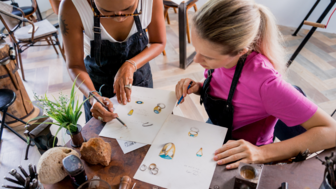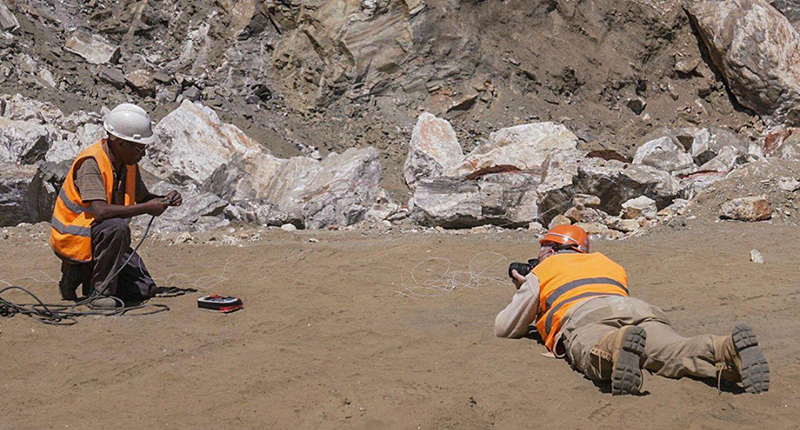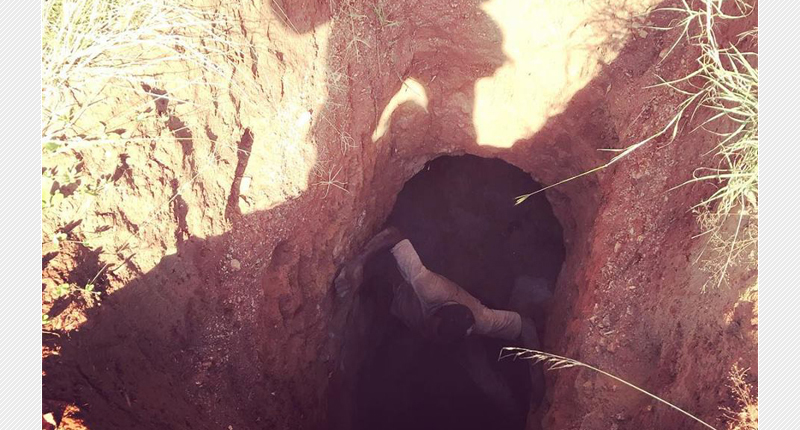The “Impermanence” collection contemplates nature through the Japanese art of Ikebana (flower arranging) and philosophy of wabi-sabi.
What It’s Like to Be a Field Gemologist, Part 2
Vincent Pardieu talks the green gem he’ll focus on this year, how the sector can work with conservation efforts and the knowledge many are lacking.

Vincent Pardieu has established a career that sees him jetting around the world to gather gemstones from the source for industry laboratories. To hear him tell it, it’s tough, important work that can also take him to interesting places and allows him to meet fascinating people.
In the second part of a two-part Q&A with the field gemologist, we talk about memorable moments in his career, where it could take him next and challenges in the market today.
(Revisit the first half of our conversation here.)
National Jeweler: Is there a project or trip that is particularly memorable to you, whether that’s for a good or bad reason?
Vincent Pardieu: Mozambique is a very special place to me because that currently is the world’s leading source for rubies. I went to Mozambique at the very beginning. I was the first foreigner, the first gemologist, to be able to visit it and I have visited this ruby deposit every year since.
But it’s not just that. It’s these stories that happen to me. I was able to meet the people from the ruby deposit in Montepuez because of people from the Niassa Reserve, so then I started to collaborate with the people from the Niassa Reserve. They are conservationists. If I want to go to an area that is dedicated to conservation, I have to ask them for permission.
I started collaborating with them and gained some interest in the Niassa Lion Project. Now, every time I go to Mozambique, I go to visit the ruby mine and I also go to visit Niassa to understand the interaction between mining and conservation because I was able to see that, in some cases in Africa, you have some discoveries of gemstones inside areas dedicated to conversation.
Sometimes it turns out to be a win-win situation because the miners and the people in charge of conservation collaborate. But in other cases, it’s a total disaster because they have conflicts.
I was able to see some very positive stories, for example in Kenya, where you have mining inside Tsavo National Park. I was able to meet Campbell Bridges during my first visit to Africa in 2005, and I was very impressed to see that he named a stone after the national park and was mining these stones just inside Tsavo and trying to support conservation in this area, helping
But that’s not always the case. Like recently in Madagascar, where you have some sapphire discoveries inside one of the last protected forest areas, you have thousands of miners invading the protected area and now there is a direct conflict between the conservationists trying to protect this area and sapphire traders and miners.
So I’m trying to help find some solutions because, from what I see, in some areas conservation and gem mining can work together, and there are some opportunities for the gem trade and conservation to collaborate, but if there are conflicts, I think it can be very dangerous for the gem trade because we are making enemies that we don’t really want to make.
NJ: So in these situations, you’re sort of playing a role where you are also trying to help figure out how to branch the two, as well as doing the field research?
VP: Yes. Because I need to speak with them in order to access these areas. When I go to an area, I go to see the authorities, and sometimes there are some security issues so I have to ask for permission. And of course, every time I speak with the authorities, they ask me my opinion (about the mining sites), because very regularly I see that the guys in charge never have visited the sites. So I try to convince them to, No. 1, let me go, and maybe let me go with some policemen or some technicians.
Then I come back and I tell them what I have seen. The whole time there is collaboration because I need to get access and be able to collect some samples, and in exchange I provide them with information and with some advice.
NJ: Is there anywhere you haven’t been or any projects you haven’t started yet that you would still like to do?
VP: There are a lot of places. During the past eight years for GIA I focused on rubies and sapphires, but this year I think I will focus on emeralds. I plan to visit quite a lot of emerald deposits in the coming year, so probably go to Brazil, Colombia and some other emerald sites I haven’t visited yet, like Madagascar and Austria. I visited some emerald mines when they were close to the ruby and sapphire mines. Emerald was my priority No. 3, and now it’s becoming my priority No. 1.
There are plenty of countries where I haven’t put my feet and with this focus on emerald, I will be able to find a good reason to go there. That will be fun.
NJ: To take a broad look at the market, from your perspective, what are some of the biggest challenges that the colored gemstone sector faces today?
VP: There are multiple. There is always the challenge that most people understand very, very little about colored stones and they have a very limited knowledge about colored stones, so this creates an opportunity for some to take advantage of the lack of knowledge.
(Specifically I’m talking about) technical knowledge about, for example, synthetic treatments and how to speak about treatment. The trade still doesn’t know how to speak about treatment. They are trying to avoid it because treatment sounds bad. Many people in the trade are afraid to speak about treatments so they prefer not to, so (the challenge is) how to handle treatment, how to communicate about treatment, how to explain to the customer that treatment is not always a bad thing.
“The trade still doesn’t know how to speak about treatment. They are trying to avoid it because treatment sounds bad. Many people in the trade are afraid to speak about treatments so they prefer not to.”For many mining areas now, you need treatment. If you don’t have treatment, only maybe less than 1 percent of the production would be able to find a market. But I don’t know any business that can survive with 1 percent of production. If there is a mining area that is active, it’s probably because there is a treatment. And, actually, untreated stones are a byproduct of mining for a stone that will be treated.
For example, rubies; to find rubies that don’t need heat treatment, there might be one stone like that out of 100. But if the 100 don’t find a market, it will not be profitable for the miner to work the project.
It’s very difficult. The miners have to be able to sell their daily production to be able to survive. Most of the miners don’t have enough capital to survive until they get an exceptional stone. Mining is not about getting exceptional stones; it’s about getting some stones and then from time to time, there will be an exceptional stone. This is one of the difficulties the trade has.
Also, speaking about origin; origin is complicated because there are many different labs with different opinions. Some labs are not doing research, some labs are. But they still all have an opinion. And the final customer has the problem of figuring out which labs they should trust the most.
For colored stones, it’s complicated because you have a great variety of choice—so many stones and so many colors. Many people feel lost because they don’t know who to trust, they feel like there’s so much to learn and they don’t know enough so maybe they should think about buying something else. How to maintain the trust in the product—I think the colored stone sector has a lot to improve in that area.
The Latest

The Texas-based jewelry retailer has set up shop in Tennessee and Arizona.

Eric Ford will step into the role, bringing with him decades of experience.

The Seymour & Evelyn Holtzman Bench Scholarship from Jewelers of America returns for a second year.

In addition to improved capabilities, the acquisition will allow the jeweler to offer support to other independent jewelers.


The “Celestial Blue” capsule collection campaign features Olympian Kateryna Sadurska.

The seasonal store, located in Mykonos, Greece, offers exclusive events, personal styling, and curated experiences.

The countdown is on for the JCK Las Vegas Show and JA is pulling out all the stops.

The New England jeweler is hosting a bridal event for the month of August.

The trade-only event will host its debut fair in the Emerald City later this month.

Its sessions will focus on inventory strategies, staff performance, retention and acquisition, emerging market trends, and more.

For its 10th anniversary, Miseno designed the “Arco” earrings based on the Arco Felice, an arch conceptualized in A.D. 95 in Miseno, Italy.

The jewelry company is one of several contributing to relief efforts in the region after the recent floods.

Inspired by fiancé Sid Wilson’s nickname for her, the white and yellow diamond ring features a unique honeycomb design.

The brand is marking its 50th anniversary with a limited-edition bangle, high jewelry suites, new collections, and more.

Goldfarb said changes in the industry, coupled with his age and the updates needed to modernize his business, drove his decision.

Longtime LVMH executive Michael Burke has stepped into the role.

Central topics of next week’s event include climate action, labor rights, artisan preservation, and value retention in producing countries.

Vickie Rokkos has joined the jewelry company as its new national sales director of North America.

Turbulence will be the new baseline for luxury as it faces its biggest potential setbacks in 15 years, a recent report said.


Sponsored by Rio Grande Jewelry Supply

The “For the Love of Fruits” collection features five fruit pendants, each holding a different meaning.

They discovered “The Dash Diamond,” named for their dog, at the Crater of Diamonds State Park earlier this month.

The “Les Pétales” collection imagines roses caught mid-bloom as a tribute to nature’s beauty.

Luxury brands charge thousands for their shoes and handbags. Jewelers pricing diamond products should take note, Peter Smith writes.

Rotenberg was an active member of the American Gem Society and an accomplished appraiser who also worked with therapy dogs at a hospital.

It follows New York-based brand Shahla Karimi Jewelry’s all-women team in “Say Yes to the Dress” meets “The Office”-style episodes.





























